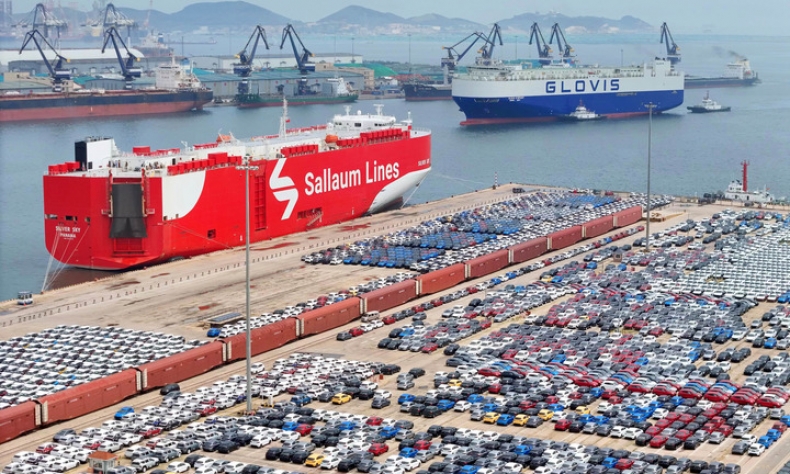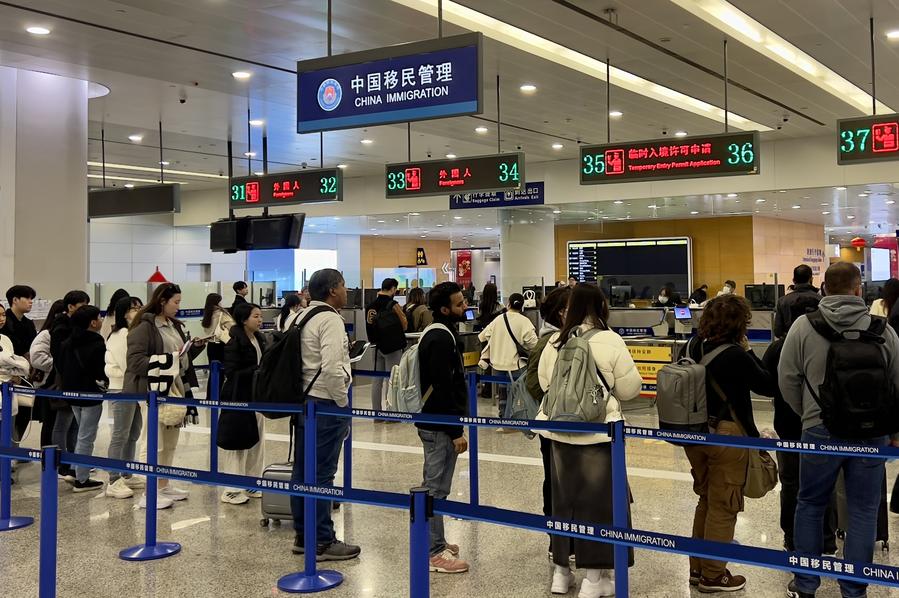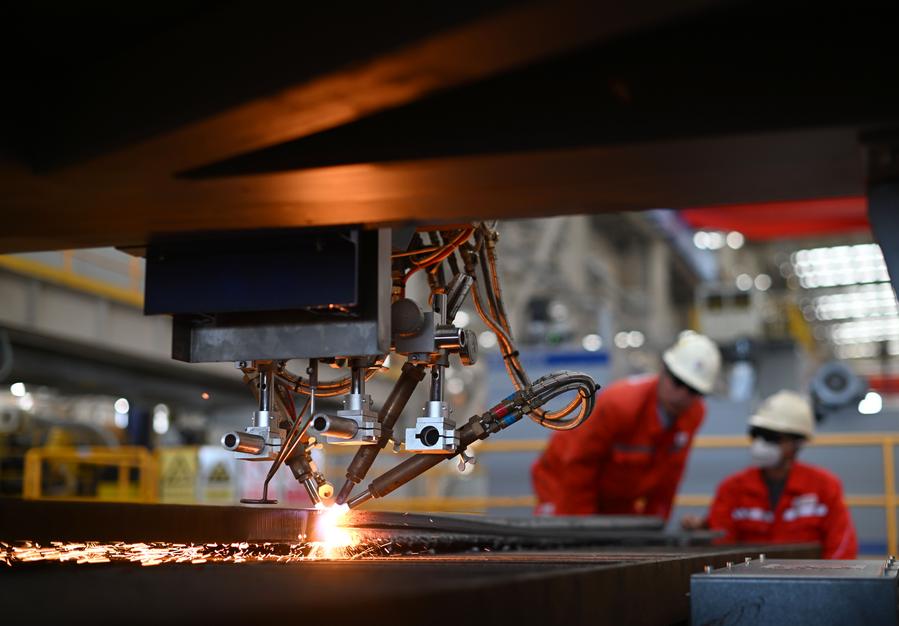China Reaches 2024 Economic Growth Target

In 2024, multiple sectors were promoting the deep integration of technological innovation and industrial innovation, injecting an endless stream of new energy into high-quality development.
China’s economy reached its annual growth target for 2024, with gross domestic product (GDP) expanding 5 percent year on year to reach 134.9084 trillion yuan ($18.77 trillion), according to data released by the National Bureau of Statistics (NBS) at a press conference on January 17.
In the fourth quarter of 2024, the Chinese economy expanded 5.4 percent year on year, after growing by 4.6 percent in the third quarter (Q3), according to the NBS.
In Q3, the Central Government introduced a series of incremental policies to encourage consumption and the creation of a more favorable business environment to boost the economy, which played a key role in achieving the full-year target, Kang Yi, Commissioner of the NBS, told the press conference.
“The supporting policies stabilized the stock and housing markets and boosted domestic demand. China’s economy made a robust V-shaped rebound in 2024,” Xu Hongcai, Deputy Director of the Economic Policy Commission at the China Association of Policy Science, told Beijing Review. The term “V-shaped recovery” describes a sharp economic rise following a sharp decline, and Xu noted that the quick ascent was aided by better-than-expected export performance and growing investment in hi-tech industries.
Main engine
Consumption continued to be a key driver. According to the NBS, retail sales, a main gauge of consumption, went up 3.5 percent year on year, with online retail sales seeing a 7.2-percent increase over the same period.
“The recovery pace of consumer spending sector is slower than expected, indicating the residual effects of the COVID-19 pandemic still linger,” Xu said.
In late August, the government introduced a trade-in policy to encourage people to replace outdated household appliances and vehicles with newer, smarter and greener ones. The policy has had a strong, positive effect on the sales of new vehicles and home appliances. In 2024, China’s total auto sales reached 31.44 million, setting a new record, the China Association of Automobile Manufacturers (CAAM) announced on January 13. The trade-in policy gave a firm boost to auto sales.
Meanwhile, consumption in tourism and e-commerce sectors continued to grow throughout the year. The ice and snow economy has heated up during the current snow season. During the past Double 11 online shopping festival, which takes place around November 11 each year, the Changbai Mountain Wanda International Resort, located in Jilin Province of northeast China, saw sales revenue from bookings approach 200 million yuan ($27.5 million). Tmall, a leading online marketplace under e-commerce giant Alibaba, recorded over 200-percent year-on-year growth in sales of down jackets, thermal wear and ski equipment during the shopping festival.
According to a report released by the China Tourism Academy on January 5, 87 major investments in the ice and snow sector were made in 2024, reaching a combined total of 85.72 billion yuan ($11.8 billion). During the 2023-24 season, China saw 430 million trips in the ice and snow leisure and tourism sector and recorded revenue of 524.7 billion yuan ($72.2 billion). During the current 2024-25 winter season, 520 million trips are expected to be made in the sector, with tourism revenue projected to surpass 630 billion yuan ($86.6 billion).

“China Travel” has emerged as a popular hashtag on global social media platforms since last year. Since China further extended its visa-free entry policy in November 2024, ordinary passport holders from 38 countries, including the Republic of Korea (ROK) and Japan, have been able to enter China for a maximum of 30 days without applying for a visa, and passport holders from 54 countries have been able to stay for up to 10 days while transiting through China.
Only a two-hour flight from the ROK, Shanghai has become a popular weekend destination for ROK travelers. The videos they have posted of themselves strolling along the city’s iconic and dramatically lit Bund at night or dining in hotpot restaurants, have further fueled Shanghai’s already blazing online popularity.
From November to late December last year, 363,000 tourists from the ROK and Japan arrived in or departed from two international airports in Shanghai, up more than 20 percent from the total in September to October, according to the Shanghai General Station of Immigration Inspection.
New vibrancy
In 2024, multiple sectors were promoting the deep integration of technological innovation and industrial innovation, injecting an endless stream of new energy into high-quality development.
According to Kang, the Global Innovation Index 2024, released by the World Intellectual Property Organization, ranked China at 11th place among the world’s most innovative economies, up one spot from the previous year.
The development trend of emerging industries represented by high-end equipment and artificial intelligence (AI) is promising, and new pillars of the industrial system are gradually forming. In 2024, the added value of hi-tech manufacturing industries increased 8.9 percent from the previous year. The new market demand is constantly giving birth to more high-quality product supplies. In 2024, in the hi-tech manufacturing industry, the added value of the intelligent consumer device manufacturing sector increased 10.9 percent from the previous year, within which the added value of the intelligent car-borne device manufacturing and smart drone manufacturing sectors increased 25.1 percent and 53.5 percent, respectively.
China is accelerating technological transformation and equipment updates in the industrial field, rejuvenating its traditional industries. In 2024, investment in technological transformation in the manufacturing sector increased 8 percent from the previous year, considerably faster than the overall investment growth rate.
In an industrial park operated by the Chinese heavy equipment manufacturer Sany Heavy Industry (Chongqing) Co. Ltd., situated in Chongqing Municipality of southwest China, an excavator rolls off the smart production line every 17.3 minutes on average, with robots handling most tasks, including welding and assessment. More than 700 robots work in the park to enable the production lines to operate mostly automatically with minimal human labor.
With the use of intelligent equipment, 300 workers manage 24 production lines, yielding an annual output of over 5 billion yuan ($687.6 million), according to the company.

The development of the new-energy industries also achieved outstanding results in 2024. The greening of the energy industry is accelerating, and the proportion of clean energy generation is constantly increasing. In 2024, hydropower, nuclear power, wind power and solar power accounted for 32.6 percent of power generation.
Sales of new-energy vehicles (NEVs) accounted for 40.9 percent of total new car sales, up 9.3 percentage points from the previous year, according to the CAAM. NEVs refer to vehicles completely or mainly driven by new energy sources, including battery electric vehicles, plug-in hybrid vehicles, and fuel-cell vehicles. Last year, NEV output reached 12.89 million units, up 34.4 percent year on year. Chinese automaker BYD delivered its 10-millionth NEV on November 18, 2024, becoming the first automaker in the world to achieve this milestone. China’s NEV exports rose 6.7 percent year on year to 1.28 million in 2024, according to the CAAM.
As of late December, the number of NEVs in use in China had reached 31.4 million, a 260-fold increase over the past decade, the Ministry of Public Security said on January 17, attributing the growth to improved charging infrastructure and more eco-friendly consumption options.
Navigating headwinds
Looking ahead, the government plans a stronger macroeconomic policy push for 2025, and has pledged to adopt a more proactive fiscal policy and a moderately loose monetary policy this year.
Contributing around 30 percent of global economic growth annually in recent years, China has been a major engine driving the world economy. The Chinese market has continued providing new opportunities for the world and China has maintained its position as the world’s second largest importer for several years, with its import reaching $2.6 trillion in 2024.
However, it remains a developing country, with a big gap in per-capita GDP compared to developed nations, Kang said.
He cautioned that challenges, including weak consumer spending, difficulties facing businesses and employment pressure, remained. Geopolitical conflicts and rising protectionism also added to the existing uncertainty.
In 2024, the national Producer Price Index (PPI) declined 2.2 percent year on year, less than the 3-percent drop in 2023. Xu said that the negative growth of PPI, a gauge of industrial product demand, was caused by weak demand in global and domestic markets, making it a key problem to address this year.
In 2024, fixed assets investment expanded 3.2 percent on a yearly basis. “But private investment saw negative year-on-year growth of 0.1 percent, suggesting that private enterprises lacked confidence,” Xu said.
According to Xu, the authorities should channel more funds into hi-tech and green sectors, and improve the expectations of private and foreign-funded enterprises to expand investment.
Xu suggested further improving people’s incomes by boosting employment and the social security system cushioning the life of low-income groups.
“The government should also shore up rural consumption through enhancing logistics in remote areas and develop new growth drivers from emerging sectors such as the silver economy, which surrounds China’s elderly,” he said.
 Facebook
Facebook
 Twitter
Twitter
 Linkedin
Linkedin
 Google +
Google +










